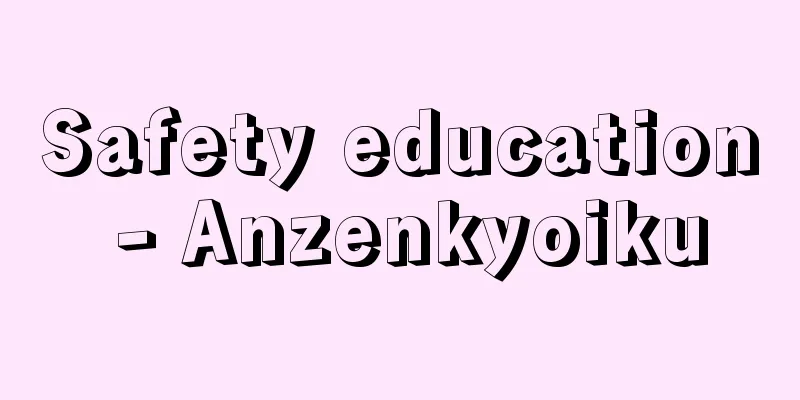Safety education - Anzenkyoiku

|
A general term for the instruction and physical training of knowledge and skills necessary to ensure physical and mental safety in a wide range of social situations, prevent various accidents, and respond to unforeseen disasters and sudden situations in order to protect one's own life and the lives of others. It can also be thought of as including the safety management of facilities, equipment, and labor. [Jiro Inoue and Tetsuo Shimomura] background The background to the need for safety education in modern society is as follows: Safety education tends to result in public interest and government measures being taken after a major disaster. One example is traffic safety education in schools. On December 5, 1966, a dump truck hit a group of kindergarten children in Yokohama, killing three and seriously injuring five. On the 15th of the same month, a dump truck ran into a group of kindergarten children in Sanage-cho, Aichi Prefecture (now Toyota City), killing 11 and injuring 18. These events directly triggered people in the field to suddenly start placing importance on traffic safety education. The 1950s was a period when the number of cars owned and the number of people obtaining driver's licenses in Japan increased rapidly. Given this, it can be said that these major disasters were bound to happen, and that they could have been prevented if proper measures had been taken in advance. [Jiro Inoue and Tetsuo Shimomura] Safety education in schoolsIn the school curriculum, safety education is positioned as part of social studies, science, physical education, and other subjects, as well as moral education, special activities, and comprehensive learning. The main contents are traffic safety, fire and evacuation drills in preparation for fires and earthquakes, and handling of fire, chemicals, and equipment. Traffic safety education is implemented in a planned manner throughout the year in kindergartens, elementary schools, junior high schools, and high schools. For example, in elementary schools, the items taught are diverse, including understanding traffic signals and road signs, how to cross the road, how to ride a bicycle, walking training, street guidance, designated school routes, and the creation of posters and slogans. As for educational methods, various teaching methods are considered, such as role-playing, which allows students to have virtual experiences rather than just one-way teaching. The aim of safety education in schools should not be limited to simply ensuring the physical and mental safety of children and students, but should also aim to help children acquire the ability to act safely on their own, and to contribute actively to the safety of people's lives now and in the future. From this point of view, the so-called "three no's" movement, which bans riding motorcycles in high schools, restricts the acquisition of driver's licenses, and regulates the purchase of motorcycles, seems a little too palliative, as it only serves to avoid immediate danger. Regarding accidents involving children and students under the supervision of schools, since the 1980s, there have been an increasing number of cases in which teachers and administrators have been held accountable for their management and sued. In this regard, the Japan Sport Council Law (Law No. 162 of 2002) has established a disaster mutual aid system, which provides appropriate medical expenses and condolence money for injuries and other disasters suffered by children and students, helping to ensure the smooth implementation of school education. [Jiro Inoue and Tetsuo Shimomura] Safety education in the general publicSafety education is not just a school issue. With the increase in opportunities to use various forms of transportation, the spread of private cars in particular, and the development of building materials and new home electrical appliances that are prone to emitting toxic gases, safety education is also an issue for adults in everyday life at home and in society. The main points of focus are to correctly understand the relevant laws and regulations, the way to use machines and equipment, to observe public morals, and to develop lifestyles that involve extra precautions. [Jiro Inoue and Tetsuo Shimomura] "Traffic Safety Guidance in Schools" edited by Aoki Takayori and Inoue Jiro (1967, Meiji Tosho Publishing)" ▽ "The Science of Safety Education" edited by Oba Yoshio and Amamura Shinpei (1969, Teikoku Association of Local Government Administration)" ▽ "The Fundamentals and Development of Safety Education" by Takuma Shinpei (1978, Gyosei)" ▽ "Lifelong Health and Safety Education" edited by Watanabe Masaki, Takizawa Toshiyuki, and Tanabe Shintaro (1988, Kobundo Publishing)" ▽ "The Behavioral Science of Safety - Safety Protected by People, Accidents Caused by People" by Mito Hideki et al. (1992, Gakubunsha)" ▽ "School Safety Practical Manual" edited by Shimomura Tetsuo (1996, Meiji Tosho Publishing) ▽ "Guide to Traffic Safety Education Instruction" edited by Tsunenari Shigeyuki (2000, Keiso Shobo) [Reference items] | | | | | | | | | | |Source: Shogakukan Encyclopedia Nipponica About Encyclopedia Nipponica Information | Legend |
|
広く社会生活において身体的、精神的な安全を確保するとともに、各種の事故を未然に防止し、不測の災害や突発的な事態に対処して、自他の生命を守るために必要な知識、技能の学習指導と身体的訓練の総称。施設・設備や労務の安全管理をも含めて考えることもある。 [井上治郎・下村哲夫] 背景現代社会において安全教育が要請される背景としては、 安全教育は、とかく大惨事のあとで人々の関心や行政の施策を促す結果になりがちである。その例が、学校における交通安全教育の場合である。1966年(昭和41)12月5日に、横浜市でダンプカーが幼稚園児をはねて死者3名、重傷者5名を出し、さらに同月15日には愛知県猿投(さなげ)町(現豊田(とよた)市)で、ダンプカーが保育園児の列に突入し、死者11名、重軽傷者18名を出したことが、直接の引き金となって、にわかに関係者が交通安全教育を重要視し始めた。昭和30年代は、日本において自動車保有台数や運転免許取得人口が急増した期間で、このことからすると、それらの大惨事は、起こるべくして起こったともいえるし、事前の対応よろしきを得れば、未然に防げたはずだともいえるであろう。 [井上治郎・下村哲夫] 学校における安全教育学校における安全教育は、教育課程上は、社会科、理科、体育などの教科や、道徳の時間、特別活動あるいは総合的な学習の時間に位置づけて行うものとされている。内容的には、交通安全に関するもの、火災・震災に備えての防火・避難訓練、火気・薬品・器具などの取扱いに関するものがその主たるものである。なかでも交通安全教育は、幼稚園、小・中・高等学校等を通じて、年間にわたって計画的に実施されている。小学校に例をとれば、信号機や道路標識の理解、道路の横断の仕方、自転車の乗り方、歩行訓練などをはじめ、街頭指導、通学路の指定、ポスターや標語の作成と、指導事項も多岐にわたっている。教育方法としても、一方的な教え込みにとどまらず、ロール・プレイングのように児童に仮想体験させるといった方法など、種々の指導法が考えられている。 学校での安全教育のねらいは、単に児童・生徒の身体的ないし精神的な安全を確保するという保護的なものにとどまらないで、児童・生徒が自ら安全な行動ができる能力を身につけ、現在ならびに将来にわたって積極的に人々の安全な生活に貢献するようになることまでをも視野に入れるべきである。この点からすると、高等学校でバイクの運転を禁止したり、運転免許の取得を制限したり、バイクの購入を規制するいわゆる「三ない運動」は当面の危険を免れるというだけの、いささか姑息(こそく)にすぎるきらいがある。 なお、学校の管理下における児童・生徒の事故に関しては、1980年代以降、教師や設置者の管理責任が問われ、裁判に訴えられる事例が増えている。この関連で、日本スポーツ振興センター法(平成14年法律162号)では災害共済制度を設け、児童・生徒の負傷その他の災害に対し、相応の医療費や見舞金を給付し、学校教育の円滑な実施を助けている。 [井上治郎・下村哲夫] 一般社会における安全教育安全教育は、単に学校だけの課題ではない。各種の交通機関を利用する機会の増加や、とくに自家用車の普及、有毒ガスを発生しやすい建材や新しい家庭電化製品の発達などの現状を考えただけでも、それは、大人にとっても家庭や社会における日常的な「自己教育」の課題である。職場での生活も含めて、関係法規や機械、器具の取扱い要領を正しく理解すること、公衆道徳を守ること、念には念を入れ、用心を重ねる生活習慣を養うことなどが、主たる着眼点である。 [井上治郎・下村哲夫] 『青木孝頼・井上治郎編著『学校における交通安全指導』(1967・明治図書出版)』▽『大場義夫・詑間晋平編著『安全教育の科学』(1969・帝国地方行政学会)』▽『詫間晋平著『安全教育の基礎と展開』(1978・ぎょうせい)』▽『渡辺正樹・滝沢利行著、田辺信太郎編著『生涯健康安全教育』(1988・高文堂出版社)』▽『三戸秀樹他著『安全の行動科学――人がまもる安全、人がおかす事故』(1992・学文社)』▽『下村哲夫編著『学校安全の実務マニュアル』(1996・明治図書出版)』▽『恒成茂行編『交通安全教育指導の手引』(2000・勁草書房)』 [参照項目] | | | | | | | | | | |出典 小学館 日本大百科全書(ニッポニカ)日本大百科全書(ニッポニカ)について 情報 | 凡例 |
>>: Occupational safety management
Recommend
Anan [city] - Anan
A city in the eastern part of Tokushima Prefecture...
Tomonosho - Tomonosho
A manor centered on Nozawa in Saku City, Nagano Pr...
Hokoji Temple
It stands alongside Toyokuni Shrine in Chayamachi,...
Ooppana - Ooppana
...There are many local names for this fish, such...
Forward spread - forward spread
The difference between the spot and forward exchan...
aphis lion (English spelling) aphislion
...Most of the eggs are green, oblong with a long...
The School of Oriental Studies
...At the start of the 20th century, Sato's h...
Eurhythmics - rythmique (English) French
A music education system created by Swiss compose...
Cestrum aurantiacum (English spelling)
…[Ichiro Sakanashi]. … *Some of the terms mention...
Crow, J. - Crow
…A case of false accusation in the persecution of...
Yan Fu
Born: 1853 [Died] 1921 A Chinese thinker and trans...
Ecological pyramid - ecological pyramid
When comparing the population densities of species...
Newspaper advertisements
〘 noun 〙 An advertisement placed in a newspaper. ※...
New triangular shell - New triangular shell
Also known as Neotrigonia. A bivalve mollusk of th...
Religious Organizations Act
This law was enacted in 1940. It aimed to unify re...









